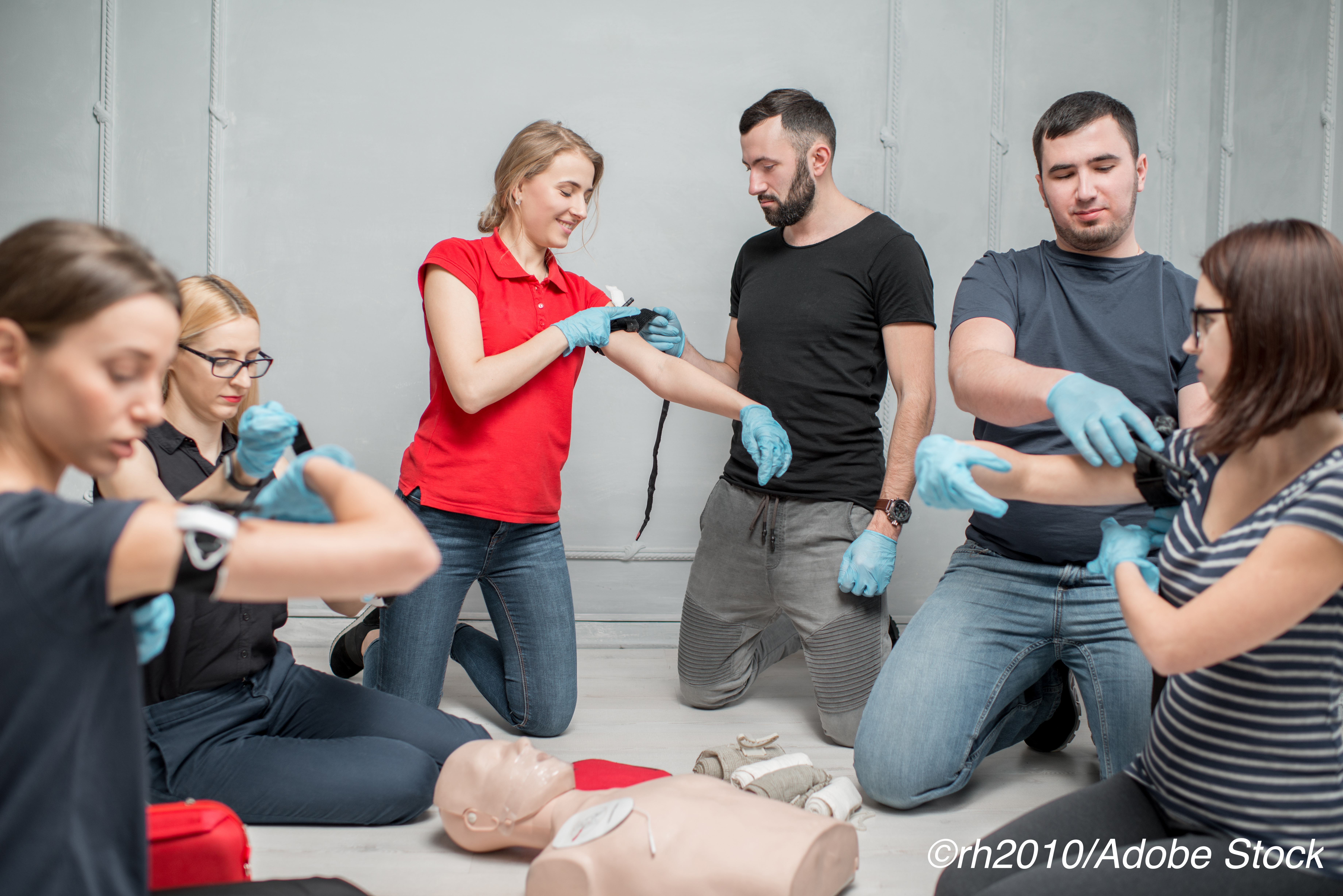Stop the Bleed (STB), the defense department’s hemorrhage-control training program designed for lay audiences, has proven effective in treating prehospital bleeding among members of the military. However, some believe the program’s tenets could be even more effective if they could permeate wider society. To address that need area, recent guidance from a panel of 45 experts offered a blueprint for introducing STB and its concepts more broadly in the civilian population.
“The National STB Research Consensus Conference identified and prioritized a national research agenda to support laypersons in reducing preventable deaths due to life-threatening hemorrhage,” wrote Eric Goralnick, MD, MS, an emergency physician and researcher with Brigham and Women’s Hospital in Massachusetts, and colleagues, in JAMA Network Open. “Investigators and funding agencies can use this agenda to guide their future work and funding priorities… To our knowledge, these findings constitute the first consensus-driven research agenda for civilian prehospital bleeding control techniques to date.”
In an editorial accompanying the study, Stephen Lu, MD, a general surgeon and researcher with Indiana University Health, and David Spain, MD, a general surgeon and professor with Stanford University School of Medicine in California, neither of whom were affiliated with the study, wrote that the effort was an important step toward expanding the initiative’s reach and scope.
“More recently, it has been noted that there may not be a broad applicability of these skills,” Lu and Spain wrote. “…To address the knowledge gaps involved in the Stop the Bleed program, Goralnick and collaborators assembled a panel of experts representing surgery, military medicine, emergency medicine, and implementation experts. They explicitly attempted to look broadly, not only on the individual medical intervention, but also on its broader psychological and social implications.”
In 2015, the Obama White House launched STB to empower non-medically skilled bystanders or responders to help control bleeding before trained professionals can arrive on the scene. The instruction essentially teaches trainees how to apply pressure and a tourniquet on a wound. There is clear evidence that hemorrhage-control principles have made a difference in the military setting, with battlefield mortality reduced by 44% in recent years, Goralnick and colleagues noted.
A year after STB’s introduction, and partially in response to the ongoing problem of mass shootings in the United States, the National Academies of Sciences, Engineering, and Medicine recommended making STB principles and training more widely available to civilians with the goal of minimizing preventable deaths. Trauma stands as the second-leading cause of death in America and the number one killer of U.S. individuals younger than 45 years old, with uncontrolled hemorrhage being the second-most common cause of trauma-related deaths.
Nevertheless, the study authors noted that no integrated approach to research had been made on the topic.
“Despite support from many national health care organizations, to date, there has not been an integrated approach to research regarding implementation, epidemiology, education, and logistics of prehospital hemorrhage control by layperson immediate responders in the civilian sector,” Goralnick and colleagues wrote. “Funding has also been limited. In addition, notwithstanding the great strides in the battlefield, limited research on the effectiveness of military techniques within the civilian sector has been performed.”
To create a national research agenda that could guide future work for prehospital hemorrhage control initiatives in the lay community, subject matter experts convened the STB consensus conference in 2019. The conference included leaders in science, government, and elsewhere, collectively representing a number of relevant fields.
The conference organized priorities into 5 broad themes: epidemiology and effectiveness including trials and prehospital data, materials including the efficacy of different tourniquet types, education including efficacy and scalability, global health including the economic impact of preventable deaths due to uncontrolled hemorrhage, and health policy addressing the incidence of preventable deaths and related policies.
The task force ultimately identified 24 “high-priority questions” — 8 for epidemiology and effectiveness, 4 for materials, 9 for education, 2 for global health, and 1 for health policy — intended to serve as the framework for a “national research agenda” on the issue.
Some of those questions included:
- What is the importance and effect of the “bystander effect” on prehospital bleeding control?
- How should a framework for public program performance assessment of STB programs be developed?
- How can we assess the effect or effectiveness of tourniquet use?
- What is the comparative effectiveness of tourniquets vs hemostatic gauze vs direct pressure?
- What are the essential standardized elements of bleeding control curriculum?
- What is the effectiveness of teaching laypeople to use improvised tourniquets?
- Can or should bleeding control be added to existing first-aid training such as CPR?
Lu and Spain indicated that the new framework appeared to create an encouraging way forward on the challenge — at a time when such solutions are needed more than ever.
“Facing a future with multiple looming threats and clear economic constraints, it is more important than ever to evaluate the effectiveness of these large-scale health initiatives,” Lu and Spain wrote. “By their broad, well-considered evaluation, Goralnick et al have shown a way forward in evaluating the implications of this prehospital intervention and creating a framework for a truly learning trauma care system.”
-
A conference of subject matter experts created a 24-point plan to bring the military’s Stop the Bleed hemorrhage-control training to civilians with no formal medical training.
-
The National Academies of Sciences, Engineering, and Medicine recommended making STB principles and training more widely available to civilians with the goal of minimizing preventable deaths, and partially as a response to mass shootings.
Scott Harris, Contributing Writer, BreakingMED™
No source appearing in this article disclosed any relevant financial relationship with industry.
Cat ID: 254
Topic ID: 253,254,254,570,730,192,925


